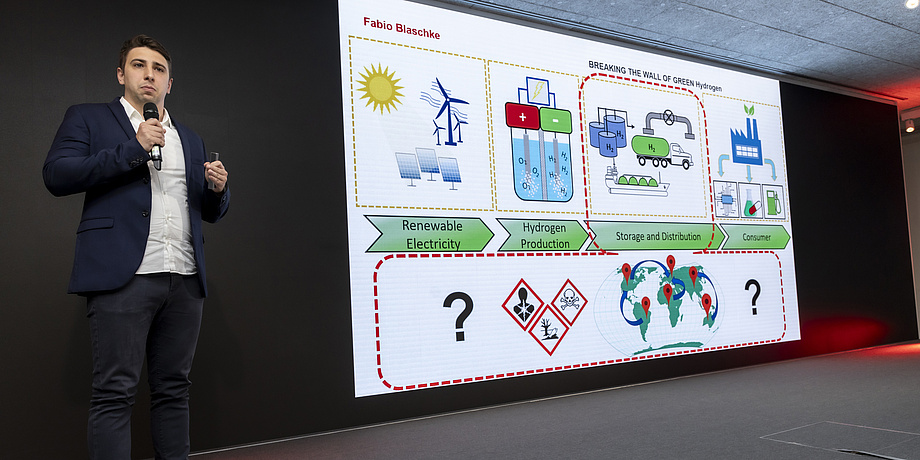The idea is that these small, red and fairly inconspicuous pellets can be used to store hydrogen safely and – above all – indirectly, in a straightforward and non-toxic approach. Fabio Blaschke is part of a research team at TU Graz’s Institute of Chemical Engineering and Environmental Technology that is investigating whether iron oxide could be used as a means for storing hydrogen. “We’re taking an indirect approach to storage. Hydrogen is used to extract the oxygen from iron oxide. The by-products, if you like, are iron and water. The small iron pellets can be stored easily at room temperature, and when the hydrogen is needed, they are exposed to steam vapour – and there you have it!" It’s as simple and practical as that. The hydrogen is not stored directly, meaning that a large number of technical problems are eliminated all at once. In gaseous form, hydrogen is stored in tanks under high pressure – the energy density is low and compressing the hydrogen requires a lot of energy. However, the molecules – the smallest in the periodic table – can diffuse through the tank walls and disappear, which happens with the tanks used in vehicles, for instance. So if the vehicle is not used for a longer period, the tank will end up only half full after a while. Liquid storage tanks, by contrast, use toxic and carcinogenic storage agents that pose a danger to the environment if they leak. But the small, red iron pellets do not require any of this; all they need is to be kept in a dry place. “Unfortunately, they leave lots of stains. Our lab technicians are always complaining about the red footprints all over the institute,” Fabio Blaschke says with a smile. The energy density of this particular means of storage is another convincing argument in its favour: up to 12 moles of hydrogen can be stored in one kilo of iron, which can subsequently be recovered in a 99.99% pure form. “This is especially important for fuel cells. They can only perform to their full potential over a longer period if they are fuelled with high-purity hydrogen.”
Rechargeable storage media
The main idea running through Blaschke’s research is the cycle stability of the iron pellets. The pellets can be used in a closed-loop system and recharged again and again. “So far we’ve completed up to 100 transformation cycles,” says Blaschke. In this regard, he and his team are paying particularly close attention to support materials that prevent the iron from sintering, which would lead to a drop in performance.
Activity and aquariums
The 30-year-old PhD student at TU Graz took a roundabout route into process engineering. “My sister has always been interested in art and languages. But whenever I played the board game Activity, I saw that I didn’t really have a talent for drawing,” he recalls. “I always wanted a chemistry set, and to find out why the world works the way it does. My mother couldn't answer all my questions either, so she suggested – tongue in cheek – that I should study chemistry one day. And that was that.” After finishing his degree in technical chemistry he spent a few years in industry before finding a subject he could work on for his PhD. “I just wanted a topic I was passionate about, one with strong prospects for the future that I could devote myself to entirely.” And Fabio always knew that the road ahead would lead him into research: “After every summer job, I would always look forward to going back to uni. I never had to force myself to study. For me, a chemistry or maths book is like a riveting novel.” The alternative might have been a career as a craftsman – possibly as a carpenter like his grandfather, who always made his grandson feel at home in his workshop. “Nowadays I just work on our experimental reactor.”
Water plays a big part in his private life, too – he and his girlfriend have a number of aquariums at home, and Fabio enjoys observing their ecosystems and monitoring the water quality. “There’s always some chemistry involved. I learn something new every day.”
This research area is anchored in the Field of Expertise “Sustainable Systems”, one of five strategic foci of TU Graz.
You can find more research news on Planet research. Monthly updates from the world of science at Graz University of Technology are available via the research newsletter TU Graz research monthly.

